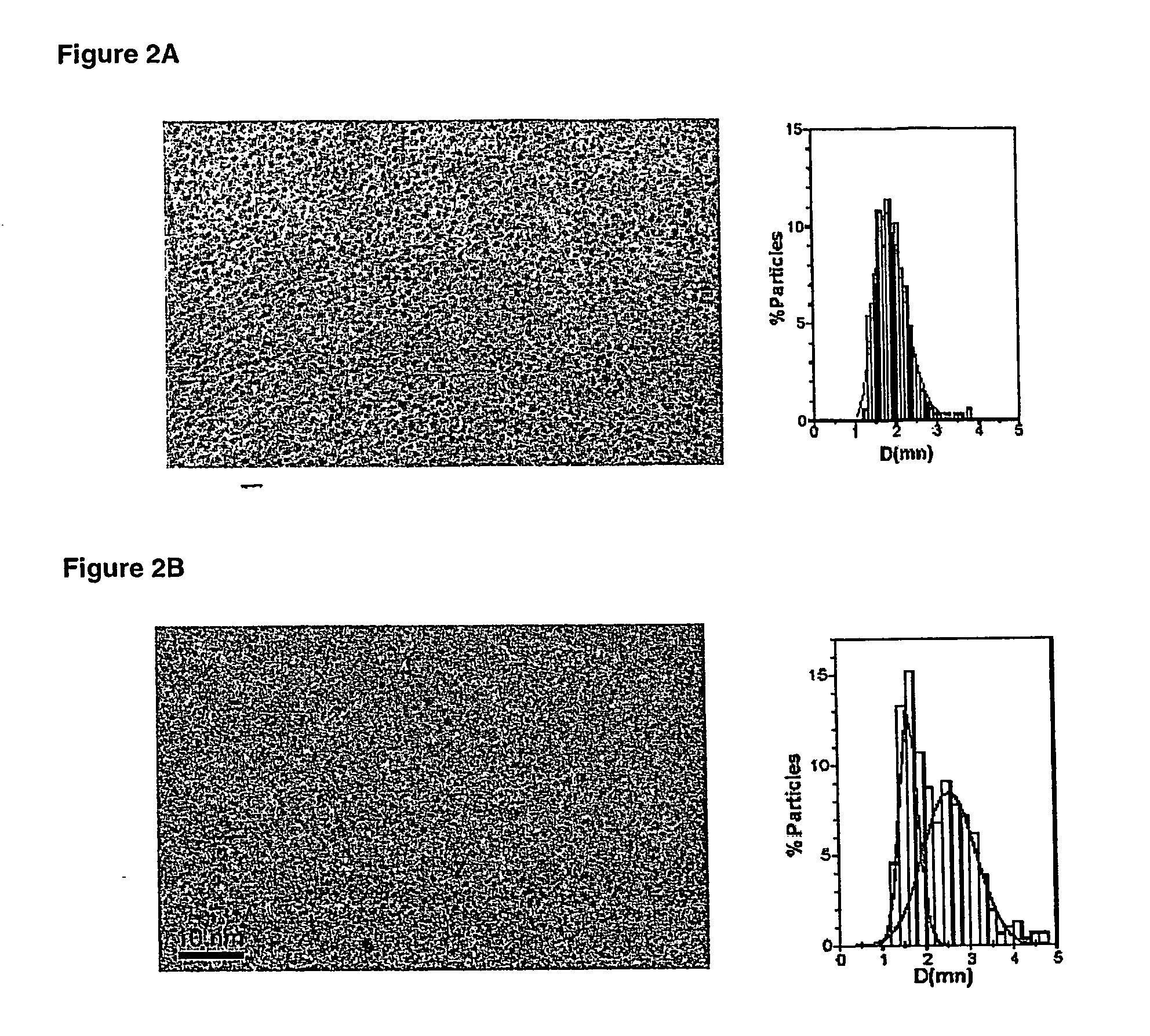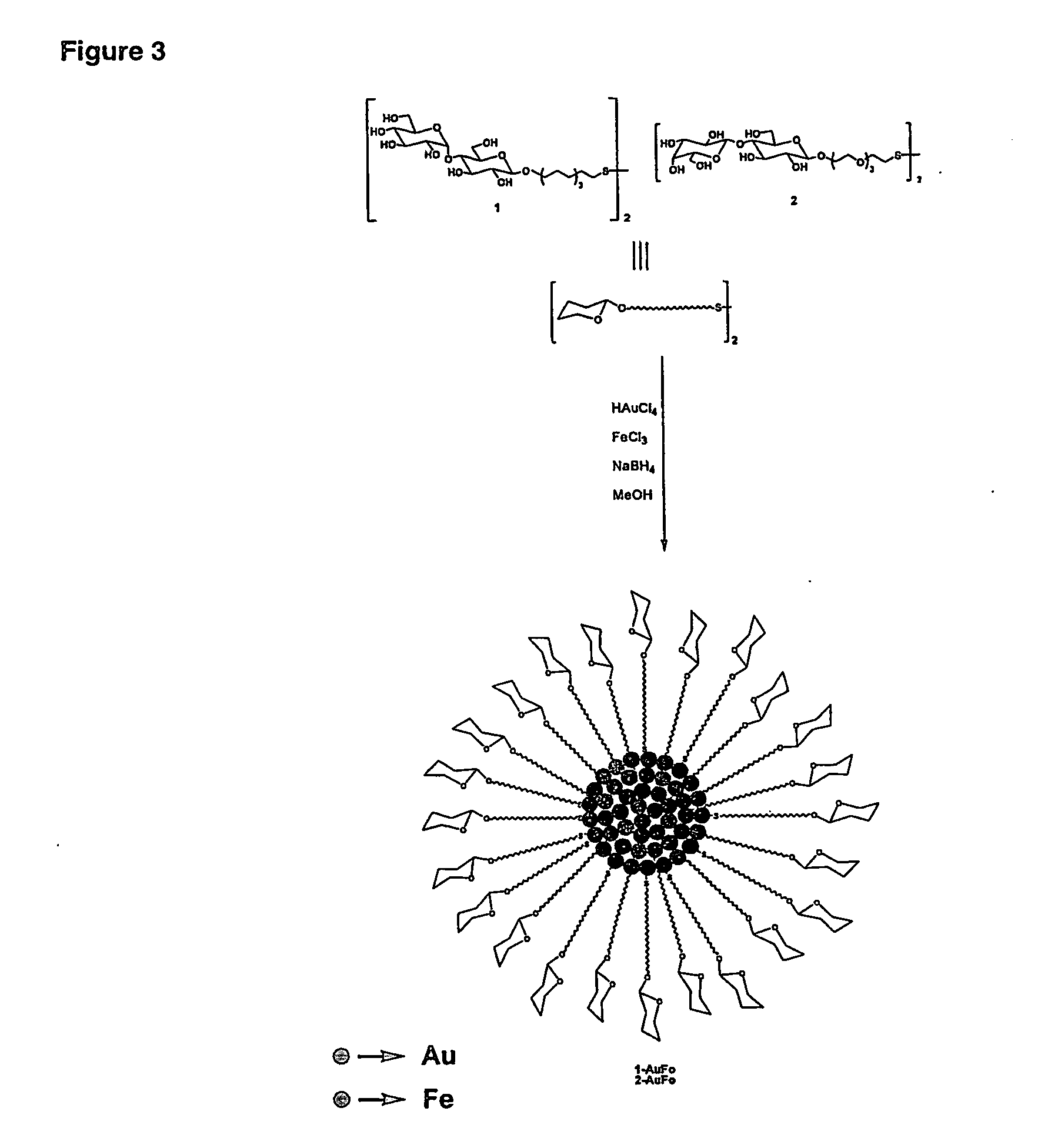Magnetic nanoparticles
a nanoparticle and magnetic technology, applied in the field of magnetic nanoparticles, can solve the problems of difficult use of colloid, affecting blood flow, and nanoparticles are often chemically unstabl
- Summary
- Abstract
- Description
- Claims
- Application Information
AI Technical Summary
Benefits of technology
Problems solved by technology
Method used
Image
Examples
example 1
Au—Fe Nanoparticles
[0125] A method of synthesising magnetic glyconanoparticles covalently bound to ligands was devised. By way of example, thiol derivatised neoglycoconjugates 1 and 2 of two significant oligosaccharides, the non-antigenic disaccharide maltose (Glcα(1→4)Glcβ1-OR) and the antigenic lactose (Galβ(1→4)Galβ1-OR), were prepared to functionalise in situ magnetic nanoparticles (FIG. 3, scheme 1). The synthesis of the disulfides 1 and 2 was carried out by glycosidation of the conveniently protected maltose and lactose derivatives with 11-acetylthio-undecanol and 11-acetylthio-3,6,9-trioxa-undecanol, respectively.[12] Both linkers have been used to test the influence of their hydrophobic or hydrophilic nature in the properties of the whole material. Compounds 1 and 2 were isolated as disulfide forms, and used in this form for the preparation of gold-iron protected glyconanoparticles. The water-soluble glyconanoparticles 1-AuFe (malto-AuFe) and 2-AuFe (lacto-AuFe) were obtain...
example 2
Magnetic Au Nanoparticles
[0140] Water soluble gold glyconanoparticles (GNPs) stabilized with self-assembled monolayers (SAMs) of different carbohydrate molecules were prepared by the chemical reduction of a metal salt precursor in aqueous solution in the presence of an excess of thiol derivatised neoglycoconjugates. The preparation sample procedure used as a starting point the Penadés et al [11][19] that produces gold GNPs in which the metal cluster has been at same time protected and functionalised with the organic molecule. The formation of Au—S covalent bonds isolate the metal cluster preventing its growth (core diameter≈2 nm) and confer on the nanoclusters exceptional stability in solution.
[0141] In this example, we report on the experimental observation of magnetic hysteresis up to room temperature in gold glyconanoparticles with average diameters of 1.4 and 1.5 nm. By increasing the ratio of thiol:gold in the Penadés procedure, GNPs sample with diameter of less than 1.5 nm c...
example 3
Au—Gd (III) Nanoparticles
[0149] Gold glyconanoparticle (GNPs) may be complexed to Gd(III) and other lanthanides to give new contrast agent. The neoglycoconjugate ligands present in the GNPs (60 to 100 molecules) are the chelating moiety.
[0150] Preparation of lactoEG4-Au(Gd) glyconanoparticles: To a solution of the corresponding gold glyconanoparticle (20.0 mg) in water (1 mL) a solution of GdCl3.(0.5 M, 1.08 mL) was added. The mixture was stirred in the absence of light during 20 h. The solution was filtered by centrifugation (MICROCON YM30, 13000 rpm, 8 min). The residue was washed (8×0.5 mL, methanol / water, ⅓). The nanoparticles were dissolved in water and lyophilized to give 17.5 mg of dark violet nanoparticles. TEM: average diameter 2.5 nm. EDX: Gd 6.8%; Au 33.2% atomic.
[0151] Determination of relaxivities: 1H NMR relaxation times T1 and T2 (37° C., pH 7.2) of the water protons in aqueous solution were measured at 1.5 Tesla in a Brucker Minispec NMR spectrometer. T1 values we...
PUM
| Property | Measurement | Unit |
|---|---|---|
| diameter | aaaaa | aaaaa |
| diameter | aaaaa | aaaaa |
| diameter | aaaaa | aaaaa |
Abstract
Description
Claims
Application Information
 Login to View More
Login to View More - R&D
- Intellectual Property
- Life Sciences
- Materials
- Tech Scout
- Unparalleled Data Quality
- Higher Quality Content
- 60% Fewer Hallucinations
Browse by: Latest US Patents, China's latest patents, Technical Efficacy Thesaurus, Application Domain, Technology Topic, Popular Technical Reports.
© 2025 PatSnap. All rights reserved.Legal|Privacy policy|Modern Slavery Act Transparency Statement|Sitemap|About US| Contact US: help@patsnap.com



